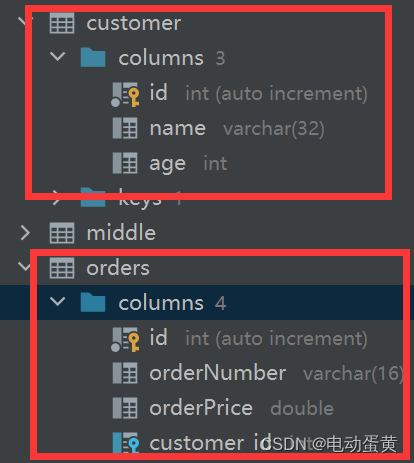一、一对多关联
在一对多关联关系中,一方(客户)中有多方(订单)的集合 ,所以要使用<collection>标签来映射多方的属性。
1、示例表如下图:

2、方法一
(1)CustomerMapper接口
public interface CustomerMapper {
// 实现通过查询顾客id,显示顾客及其订单
Customer getById(int id);
}(2)CustomerMapper.xml
<mapper namespace="com.jht.mapper.CustomerMapper">
<resultMap id="customerMap" type="customer">
<!-- 绑定主键 -->
<id property="id" column="cid"></id>
<!-- 绑定非主键 -->
<result property="name" column="name"></result>
<result property="age" column="age"></result>
<!-- 绑定非表中属性 -->
<collection property="ordersList" ofType="orders">
<!-- 绑定主键 -->
<id property="id" column="oid"></id>
<!-- 绑定非主键 -->
<result property="orderNumber" column="orderNumber"></result>
<result property="orderPrice" column="orderNumber"></result>
</collection>
</resultMap>
<select id="getById" parameterType="int" resultMap="customerMap">
select c.id cid,name,age,o.id oid,orderNumber,orderPrice,customer_id
from customer c left join orders o on c.id = o.customer_id
where c.id = #{id}
</select>
</mapper>(3)测试
@Test
public void testGetById(){
Customer cus = customerMapper.getById(3);
System.out.println(cus);
}3、方法二
(1)CustomerMapper接口
public interface CustomerMapper {
// 实现通过查询顾客id,显示顾客及其订单
Customer getById(int id);
// 方法二
Customer getById2(int id);
}(2)CustomerMapper.xml
<resultMap id="customerMap2" type="customer">
<id property="id" column="id"></id>
<result property="name" column="name"></result>
<result property="age" column="age"></result>
<collection property="ordersList" ofType="orders" column="id" select="selectOrdersByCustomerId"/>
</resultMap>
<select id="getById2" parameterType="int" resultMap="customerMap2">
select * from customer where id=#{id}
</select>
<select id="selectOrdersByCustomerId" parameterType="int" resultType="orders">
select * from orders where customer_id = #{id}
</select>(3)测试
@Test
public void testGetById2(){
Customer cus = customerMapper.getById2(1);
System.out.println(cus);
}4、方法三(推荐方法)【每个mapper里只有自己的增删改查】
(1)CustomerMapper接口
public interface CustomerMapper {
// 实现通过查询顾客id,显示顾客及其订单
Customer getById(int id);
// 方法二
Customer getById2(int id);
// 方法三
Customer getById3(int id);
}(2)CustomerMapper.xml
<resultMap id="customerMap3" type="customer">
<id property="id" column="id"></id>
<result property="name" column="name"></result>
<result property="age" column="age"></result>
<collection property="ordersList" ofType="orders" column="id" select="com.jht.mapper.OrdersMapper.getByOrdersId"></collection>
</resultMap>
<select id="getById3" parameterType="int" resultMap="customerMap3">
select * from customer where id=#{id}
</select>(3)OrdersMapper.xml
<select id="getByOrdersId" resultType="orders" parameterType="int">
select * from orders where customer_id=#{id}
</select>(4)测试
@Test
public void testGetById3(){
Customer cus = customerMapper.getById3(1);
System.out.println(cus);
}二、多对一关联
在多对一关联关系中,多方(订单)中持有一方(客户)的对象,要使用标签<association>标签来映射一方的属性。
(1)OrdersMapper接口
public interface OrdersMapper {
// 通过商品id查询该订单信息
Orders getByOrdersId(Integer id);
// 通过商品id查询该订单的购买人信息
Orders getBuyer(Integer id);
}
(2)OrdersMapper.xml
<select id="getByOrdersId" resultType="orders" parameterType="int">
select * from orders where customer_id=#{id}
</select>
<resultMap id="ordersMap" type="orders">
<id property="id" column="id"></id>
<result property="orderName" column="orderName"></result>
<result property="orderPrice" column="orderPrice"></result>
<association property="customer" javaType="customer" column="customer_id" select="com.jht.mapper.CustomerMapper.getAll"/>
</resultMap>
<select id="getBuyer" parameterType="int" resultMap="ordersMap">
select * from orders where id=#{id}
</select>(3)CustomerMapper.xml
<!-- 嵌套查询 -->
<select id="getAll" parameterType="int" resultType="customer">
select * from customer where id = #{id}
</select>(4)测试
@Test
public void testGetBuyer(){
Orders ors = ordersMapper.getBuyer(11);
System.out.println(ors);
}三、一对一关联
四、多对多关联
多对多关联中,需要通过中间表化解关联关系。中间表描述两张主键表的关联。中间表没有对应的实体类。Mapper.xml文件中也没有中间表的对应标签描述,只是在查询语句中使用中间表来进行关联。
(1)BookMapper接口
public interface BookMapper {
// 查询全部图书,并且查询每本书所属的类型
List<Book> findAll();
}(2)BookMapper.xml
<mapper namespace="com.jht.mapper.BookMapper">
<resultMap id="bookMap" type="book">
<id property="bid" column="bid"></id>
<result property="bname" column="bname"></result>
<collection property="categoryList" ofType="category">
<id property="cid" column="cid"></id>
<result property="cname" column="cname"></result>
</collection>
</resultMap>
<select id="findAll" resultMap="bookMap">
select *
from book b inner join middle m on b.bid = m.m_bid
inner join category c on c.cid = m.m_cid
</select>
</mapper>(3)测试
@Test
public void testFindAll(){
List<Book> books = bookMapper.findAll();
books.forEach(i -> System.out.println(i));
}五、总结
总结:无论是什么关联关系,如果某方持有另一方的集合,则使用<collection>标签完成映射,如果某方持有另一方的对象,则使用<association>标签完成映射。






















 1013
1013











 被折叠的 条评论
为什么被折叠?
被折叠的 条评论
为什么被折叠?








